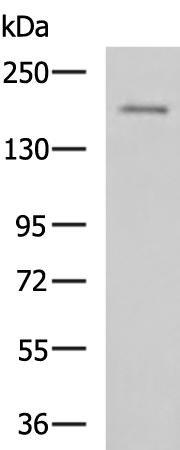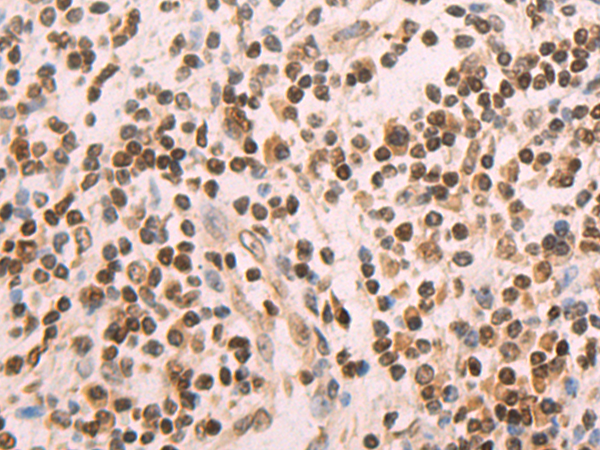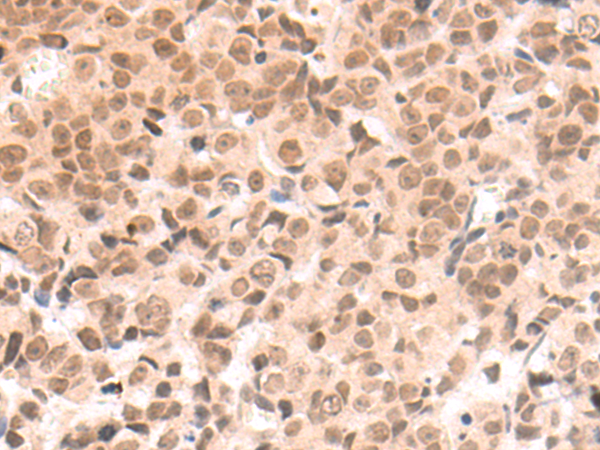


| WB | 咨询技术 | Human,Mouse,Rat |
| IF | 咨询技术 | Human,Mouse,Rat |
| IHC | 1/50-1/200 | Human,Mouse,Rat |
| ICC | 技术咨询 | Human,Mouse,Rat |
| FCM | 咨询技术 | Human,Mouse,Rat |
| Elisa | 1/5000-1/10000 | Human,Mouse,Rat |
| Aliases | WSTF; WBSCR9; WBSCR10 |
| WB Predicted band size | 171 kDa |
| Host/Isotype | Rabbit IgG |
| Antibody Type | Primary antibody |
| Storage | Store at 4°C short term. Aliquot and store at -20°C long term. Avoid freeze/thaw cycles. |
| Species Reactivity | Human, Mouse |
| Immunogen | Synthetic peptide of human BAZ1B |
| Formulation | Purified antibody in PBS with 0.05% sodium azide and 50% glycerol. |
+ +
以下是关于BAZ1B抗体的3篇参考文献及其摘要概括:
1. **文献名称**: "The chromatin remodeler BAZ1B protects genome stability and prevents premature senescence"
**作者**: Yoshimura SH, et al.
**摘要**: 本研究利用BAZ1B抗体进行免疫沉淀和染色质分析,发现BAZ1B通过调控核小体组装维持基因组稳定性,其缺失会导致DNA损伤积累和细胞早衰。
2. **文献名称**: "BAZ1B is a novel regulator of the Wnt/β-catenin pathway in colorectal cancer"
**作者**: Dahl JA, et al.
**摘要**: 通过BAZ1B抗体的ChIP-seq和Western blot实验,研究揭示BAZ1B在结直肠癌中通过结合β-catenin增强Wnt信号通路活性,促进肿瘤进展。
3. **文献名称**: "Developmental regulation of BAZ1B/ACF1-mediated chromatin remodeling in neural crest cells"
**作者**: Stopka T, Skoultchi AI.
**摘要**: 该研究使用BAZ1B抗体进行免疫荧光和染色质分析,表明BAZ1B在神经嵴细胞分化中通过调控染色质可及性影响关键发育基因的表达。
4. **文献名称**: "BAZ1B contributes to neurodevelopmental phenotypes in Williams syndrome"
**作者**: Kitagawa H, et al.
**摘要**: 通过BAZ1B抗体的组织样本分析,研究发现BAZ1B单倍剂量不足可能导致威廉姆斯综合征患者的神经发育异常,涉及突触功能相关基因的失调。
以上文献展示了BAZ1B抗体在癌症机制、神经发育及基因组稳定性研究中的应用,涵盖ChIP-seq、免疫荧光和Western blot等多种实验方法。
The BAZ1B antibody targets the BAZ1B protein (Bromodomain Adjacent to Zinc Finger Domain 1B), also known as WSTF (Williams syndrome transcription factor), a key component of the chromatin remodeling complex ISWI. BAZ1B plays a critical role in regulating nucleosome spacing, DNA replication, and repair by interacting with ATP-dependent chromatin remodelers like SMARCA5 (SNF2L). It contains a WAC domain, a PHD finger, and a bromodomain, enabling interactions with histones and other chromatin-associated proteins.
BAZ1B antibodies are widely used in research to study gene expression regulation, chromatin dynamics, and epigenetic modifications. They are essential tools in techniques like Western blotting, immunofluorescence, and ChIP-seq to assess BAZ1B localization, expression levels, and its role in maintaining genomic stability.
BAZ1B is notably linked to Williams-Beuren syndrome (WBS), a neurodevelopmental disorder caused by a heterozygous deletion on chromosome 7q11.23. which includes the BAZ1B gene. Studies using BAZ1B antibodies have revealed its involvement in craniofacial development and neural cell differentiation, providing insights into WBS pathology. Researchers also utilize these antibodies to explore BAZ1B's oncogenic potential, as its dysregulation is observed in certain cancers. Commercial BAZ1B antibodies are typically validated for specificity in human and model organisms, aiding cross-species comparative studies.
×